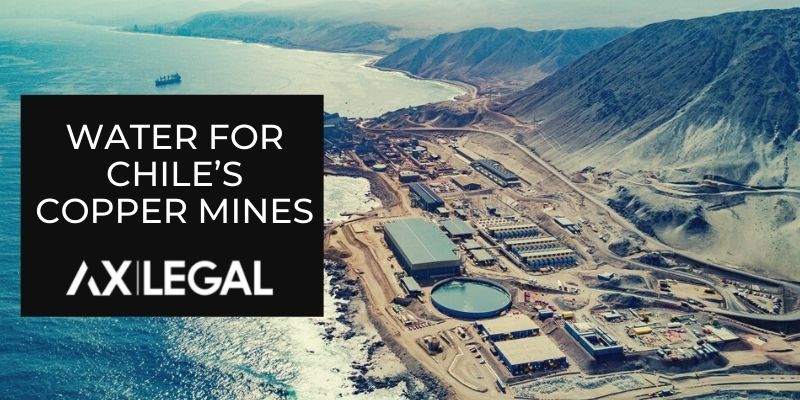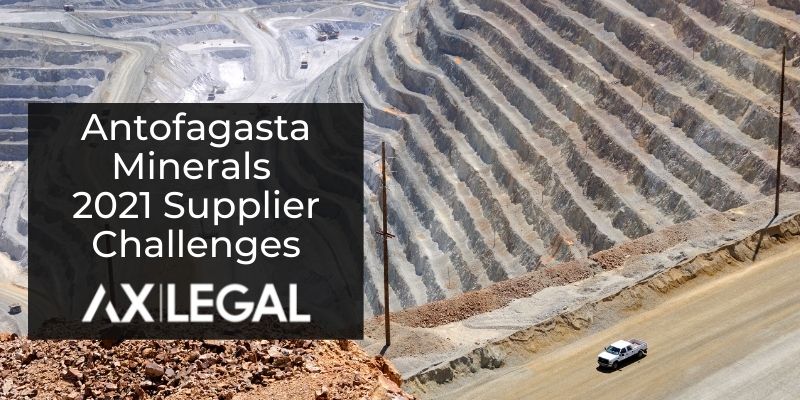Water for Chile’s Copper Mines

Chile has faced a decade-long drought that has impacted local communities and whole industries alike. Over 400,000 people are receiving water deliveries from the government, mainly in rural communities where groundwater has run dry. Whole lakes in the central region of Chile which once were dotted with recreational boats are now completely dry as well.
The drought has had a severe impact on agriculture, the largest users of water in the country. In August 2021, an agricultural emergency was declared by the President for Coquimbo, Valparaiso, O’Higgins, and Maule cities. An emergency fund of over US$10 million was created for farmers.
Hydroelectric energy which makes up 30% of the energy generated in the country has been affected and reservoirs are at historic lows. Hydroelectric generation in 2021 has been 16.3% lower than that of 2019. This year the country delayed retiring a coal-fired plant to cover the hydroelectric deficit.
In response to the water scarcity, government has addressed the crisis by investing in water conservation and storage, creating a post for a subsecretary of water and establishing a working group on water management, as well as a climate change observatory.
According to the environment ministry, 73% of the country’s water is used for agriculture, while industry consumes 12%, mining consumes 9%, and residents only 6%.
Water and the Mining Sector
Although the mining industry only uses 9% of the countries water, most operations are located in Northern Chile where water is the scarcest. Water scarcity has already started impacting mining operations.
BHP’s Cerro Colorado copper mine was ordered in September of this year to stop pumping water from their aquifers for 90 days. Antofagasta Minerals earlier this year cut its copper production target for the year due to the water shortage as it waits for its desalination plant to start operating in 2022.
Over the years, the industry has been proactive with switching to sea or desalinated water in their operations. This trend will only accelerate as we head into the future. The Chilean Copper Commission (Cochilco) estimates that higher water intensity in ore processing will more than triple the industry’s seawater consumption by 2029
Currently, there are 8 desalination plants and 3 seawater impulsion systems operating which together represent 25% of the non-recirculated water used by the copper industry. By 2031, the Antofagasta Region will have the largest number of desalination plants in the country, supplying 66% of the copper industry’s consumption in that region.
There are 15 desalination plant projects on file that are expected to be built before 2031 including an infrastructure project being built in Coquimbo by Antofagasta Minerals, which involves a 150-km long pipeline to transport the water; Codelco’s Northern District Desalination Plant in Antofagasta; the Quebrada Blanca Hipógenos project of Teck in Tarapacá, and the Santo Domingo project of Capstone Mining in Atacama.
Desalination Plant Considerations
There are some very real considerations that mining companies need to take into consideration when deciding to use seawater or desalinated water in their processes.
Energy Costs – The cost of desalinating water is not cheap. The country has been using more efficient membrane technology over thermal plants, but the energy usage is still significant. In addition, with mines located at high altitudes, the water then needs to be transported using pump stations which is energy intensive and has greater capital expenditures.
Environmental Costs – The brine discharge is always a concern, particularly for fishing communities located near by. Plants need to be designed with sophisticated dispersion system to reduce brine concentrations. Given the fragile ecosystems, companies have to invest in environmental monitoring to ensure they are within their limits.
Desalinated Water vs Direct Seawater Costs – Using seawater directly in operations saves on capital and energy costs but transporting the seawater requires non-corrosive piping for both the pipelines and plants. It is also more expensive to transport due to higher viscosity and density of the salt water.
Moving into the Future
Mining operations are going to continue to need water, particularly as ore grades degrade and more material needs to be processed to recover the same amount of copper. There are some particularly important areas where mining companies are going to need to focus on to ensure they have the water needed to operate.
Shared Infrastructure – Due to the cost of building out the infrastructure, it will be important for companies to find opportunities where they can share water infrastructure (pipelines, powerlines) to lower both capital and operating costs. The addition of seawater desalination to a large-scale project adds at least a billion dollars to project capex. Escondida spent more than $3 billion for a massive plant that desalinates 2,500 litres per second (lps) in 2018. Sharing infrastructure will be more cost efficient.
Water Recycling – Companies have already taken large steps to recycle as much of their current water as possible. More can be done in this aspect and technology will play a part in reducing the water needed in processing, reusing water from tailings, and reducing the general water usage across mine sites (ex. water used on haul roads to reduce dust).
Energy Usage – Desalination plants and the pumping stations used to move the water to the mine sites are extremely energy intensive. Fortunately, the North of Chile has some of the best renewable capacity in the world and it will be extremely important that companies tap into this energy to lower their energy costs and reduce the need of carbon-based energy sources to power their infrastructure.
Environmental and Social License – Desalination plants are going to be put pressure on the marine ecosystem. It will be important for companies to monitor their brine discharge and ensure that are no long-term consequences on the environment. They will also need to partner with local communities, so they also benefit and have access to water through the existing infrastructure. The environmental and community aspect is extremely important in order for the mining companies to have a social license.
Ax Legal is an advisory firm that works with foreign companies in Latin America. Our team of legal and commercial advisors have a distinguished track record of helping foreign technology and services companies to grow and operate in Latin America. Over the years, we have worked with starts up, mid-size businesses, and publicly listed companies. The one common factor that connects are clients is that they are leaders in their field, providing innovative technologies and services to the industrial sectors.
To better understand how we can support you in the Region, please contact Cody Mcfarlane at cmm@ax.legal



 Santiago
Santiago Sydney
Sydney Lima
Lima